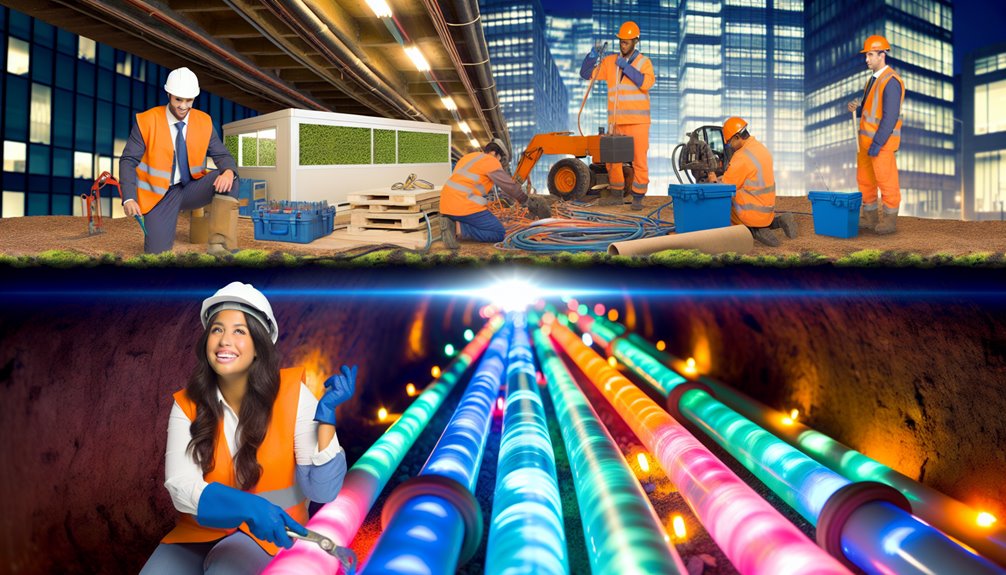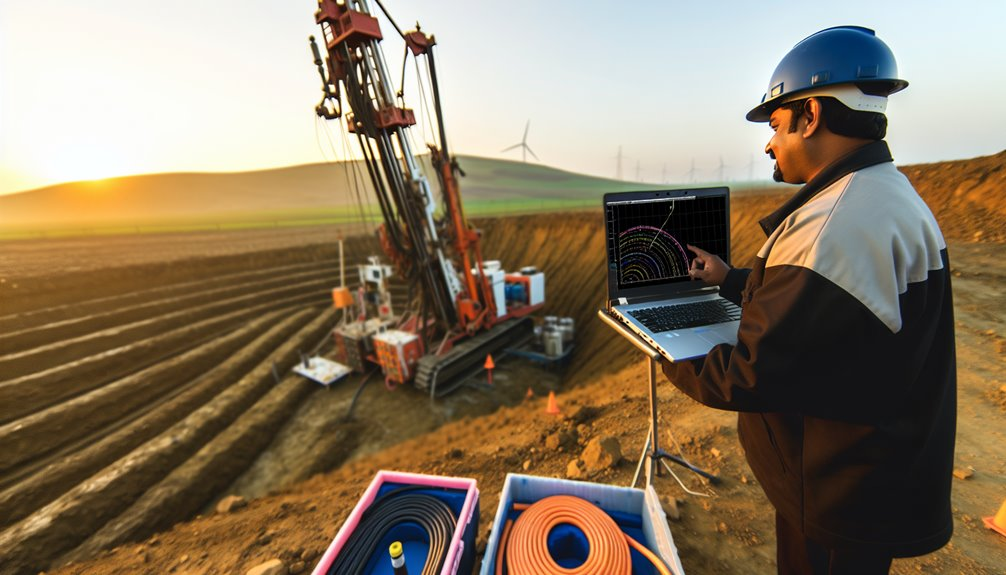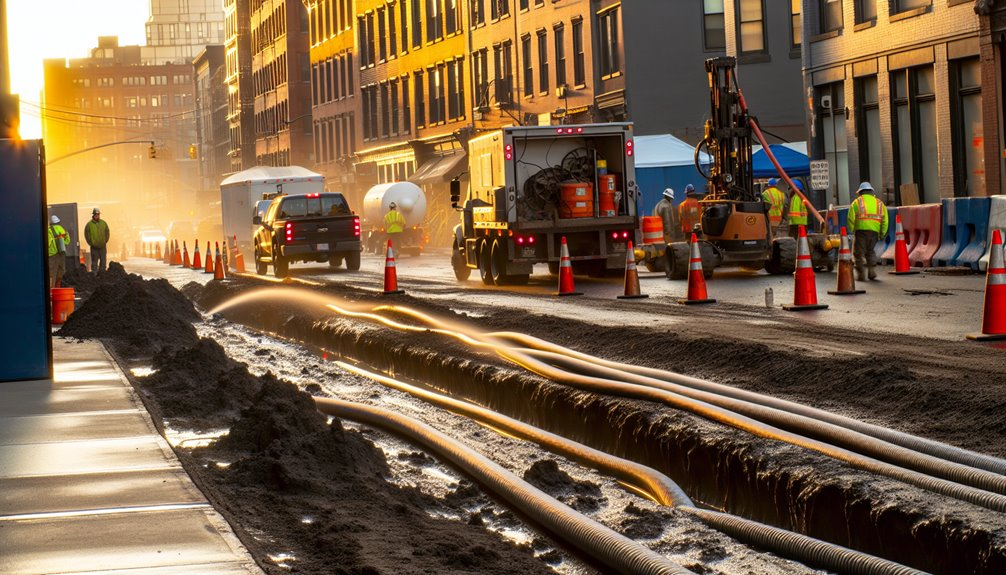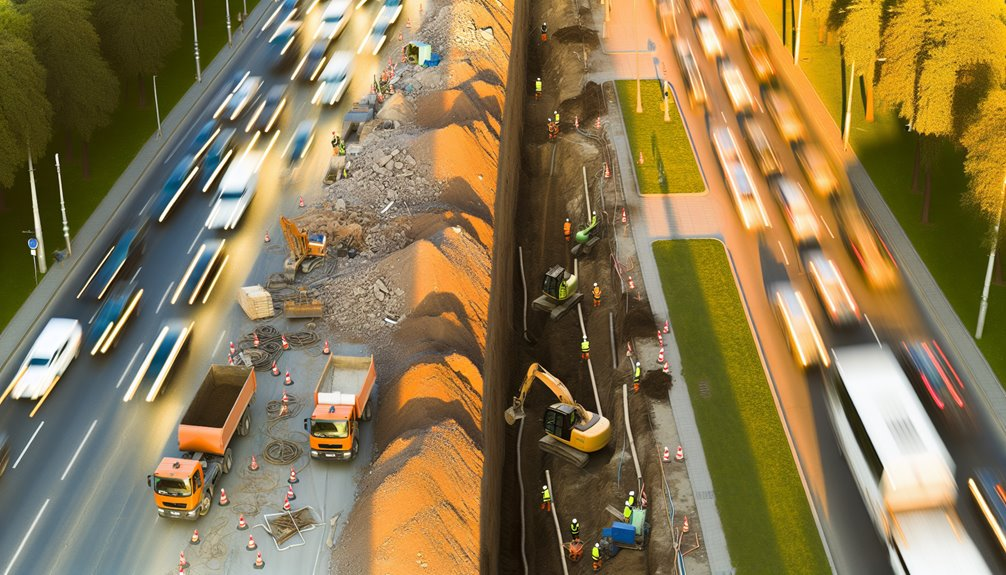As you commence on underground utility projects, consider the significant advantages of trenchless technology. This method not only preserves the natural landscape but also slashes GHG emissions by up to 90% compared to traditional excavation. Furthermore, by integrating high-density polyethylene pipes, renowned for their low environmental impact and superior longevity, you're committing to sustainable construction practices. These choices not only comply with stringent environmental standards but also promise substantial cost savings in long-term maintenance. This is just the surface of how modern practices are reshaping this field.
The Rise of Trenchless Technology in Utility Installation
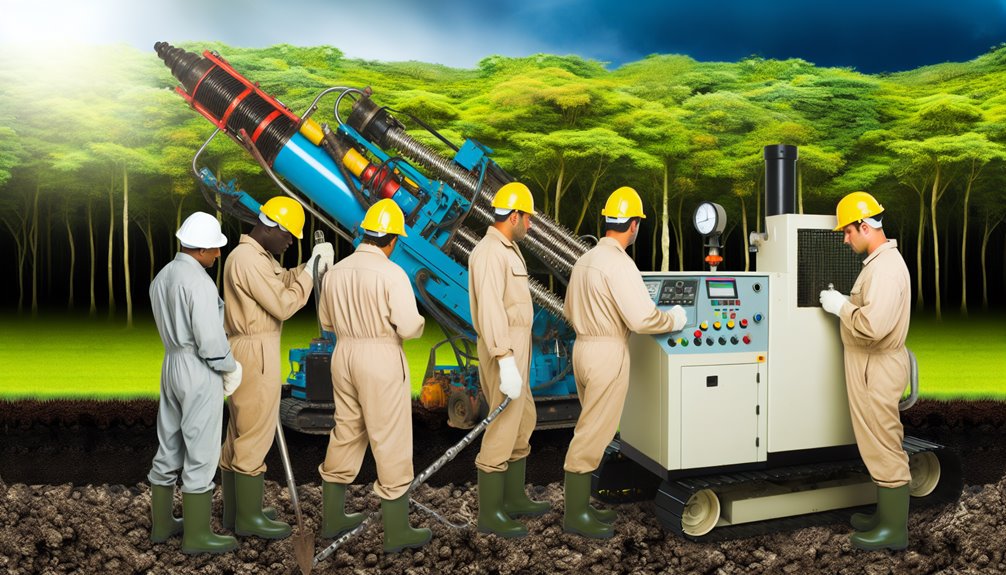
As the demand for more sustainable construction methods grows, trenchless technology is increasingly becoming the go-to approach for underground utility installation. You'll find this method not only minimizes environmental disruption but also streamlines the process. By sidestepping extensive excavation, trenchless technology markedly reduces carbon emissions and preserves the natural landscape. Additionally, it curtails soil erosion and protects root structures better than traditional methods. Utilizing innovative installation methods like horizontal directional drilling and cured-in-place pipe lining, trenchless technology offers you a less invasive option. These techniques guarantee quicker project turnaround and less community disturbance. For urban areas or ecologically sensitive zones, where minimizing impact is vital, adopting trenchless solutions can achieve both operational efficiency and environmental conservation. The durability of trenchless repairs, which can last up to fifty years, significantly extends the lifecycle of utility infrastructures, promoting sustainability (lasting up to fifty years).
Utilizing Durable and Recyclable Materials
You're now shifting to sustainable underground utility construction by focusing on durable and recyclable materials.
By incorporating eco-friendly material options like Recycled Concrete Aggregate and Recycled Asphalt Pavement, you greatly reduce environmental impacts and support waste management.
These practices not only lower project costs but also align with broader sustainability goals, making them a strategic choice for long-term infrastructure development. Additionally, the adoption of corrosion-resistant pipes enhances resilience against environmental stressors, further promoting sustainability in utility projects.
Eco-Friendly Material Options
To enhance sustainability in underground utility construction, selecting eco-friendly materials that are both durable and recyclable is critical.
Focusing on precast concrete, you'll find its strength and durability ideal for maintaining structural integrity in challenging environments. Its noncombustibility and heat resistance safeguard essential utilities, while its efficient installation processes save time and reduce labor costs.
Switching to HDPE pipes, you'll benefit from their flexibility and lightweight nature, which simplifies handling and installation. Their corrosion resistance and zero leak rate due to seamless fusion increase reliability and efficiency.
Both precast concrete and HDPE pipes are environmentally safe, supporting your drive towards innovative, sustainable construction practices without compromising on performance or safety.
Benefits of Material Recycling
Utilizing durable and recyclable materials in underground utility construction not only conserves natural resources but also considerably cuts costs. By integrating these materials, you're tapping into significant economic incentives.
For instance, you save about 25% on material costs and reduce transportation expenses by repurposing local resources. Additionally, this practice earns valuable LEED points, boosting the market value of your projects.
The environmental impact is equally compelling. Using recycled materials minimizes waste, with a substantial reduction in landfill use—around 1,800 pounds per person.
It also decreases CO2 emissions by up to 13%, preserving biodiversity and reducing the strain on virgin resources. Embracing this approach enhances operational efficiency, making your project not just economically viable but also environmentally sustainable.
Reducing Carbon Footprint With Advanced Machinery
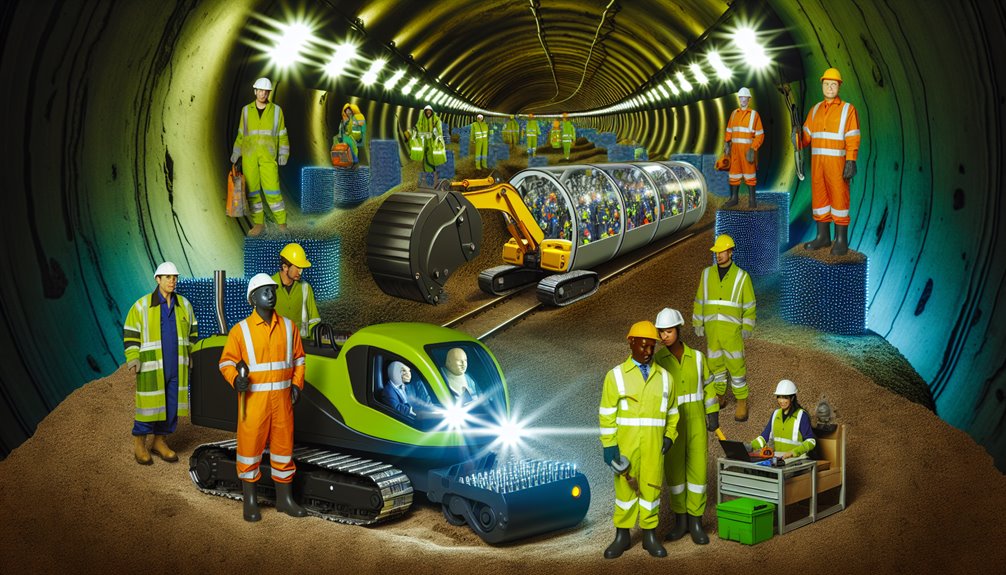
You can substantially lower your project's environmental impact by adopting eco-friendly equipment innovations that incorporate cutting-edge technologies designed to minimize ecological disturbance.
By enhancing fuel efficiency in your machinery, you're not only reducing operational costs but also cutting down on emissions.
In addition, integrating emission control technologies guarantees compliance with stringent environmental standards, helping you achieve sustainable construction objectives efficiently.
Eco-Friendly Equipment Innovations
Innovations in eco-friendly equipment are revolutionizing the reduction of carbon footprints in underground utility construction.
You'll find electric machine advancements particularly compelling. Electric excavators, for instance, slash well-to-wheel emissions by 95% compared to their diesel counterparts. This electrification not only eradicates direct tailpipe emissions but also curtails on-site noise, enhancing the work environment while slashing operating costs by eliminating routine refueling.
Simultaneously, hybrid technology integration offers a pragmatic bridge towards greener methods. Hybrid machinery, blending internal combustion engines with electric power, allows for flexible operation modes—electric for lighter tasks and diesel when more horsepower is required.
This dual approach not only reduces emissions but also maintains robust performance, making it an ideal choice for varied construction demands.
Fuel Efficiency Improvements
As the construction industry shifts towards sustainability, advanced machinery designs play a pivotal role in enhancing fuel efficiency and reducing the carbon footprint of underground utility projects.
You're at the forefront, embracing technology to revolutionize how we build beneath the surface.
- Optimized Energy Consumption: Using Tunnel Boring Machines (TBMs) that require less energy, directly contributing to fuel conservation strategies.
- Remote Operation and Precision: Deploying ground-penetrating radar and real-time 3D laser scans guarantees energy-efficient operations by minimizing unnecessary excavation and material waste.
- Innovative Material Use: Implementing low-carbon concrete and prefabricated segmental linings reduces the volume of materials needed, thereby reducing associated energy consumption.
These strategies are crucial for your projects to meet modern sustainability standards and optimize operational efficiency.
Emission Control Technologies
While shifting to more sustainable underground utility construction methodologies, it's crucial to focus on emission control technologies that directly reduce the carbon footprint of diesel-powered equipment.
Implementing Mine Safety and Health Administration-approved low-emission engines and integrating engine derating practices are pivotal. Furthermore, the use of diesel oxidation catalysts and diesel particulate filters greatly enhances particulate reduction.
These systems, when combined with Ultra Low Sulfur Fuel, achieve the highest emission curtailment. Regular emission monitoring through monthly tailpipe gas checks and diesel particulate matter measurements guarantees compliance and efficiency.
Such precision in the deployment of catalytic and filtration systems not only meets but often exceeds environmental standards, paving the way for greener, more responsible underground construction projects.
Enhancing Efficiency Through Digital Mapping and GIS
To enhance efficiency in underground utility construction, adopting digital mapping and GIS is essential. These technologies aren't just tools; they're crucial components in streamlining your projects while ensuring environmental and safety compliance.
By leveraging precise utility mapping, you're not only avoiding costly mistakes but also paving the way for innovative construction practices.
- Digital Collaboration boosts project coordination, ensuring all stakeholders have access to real-time, accurate data.
- Mapping Accuracy is enhanced through advanced GIS applications, reducing risks associated with underground construction.
- Eco-Conscious Decision Making is facilitated by detailed 3D models and thorough utility data, supporting your commitment to sustainable construction practices.
Embrace these cutting-edge tools to stay ahead in a competitive and increasingly regulated industry.
Water Conservation Techniques in Underground Construction
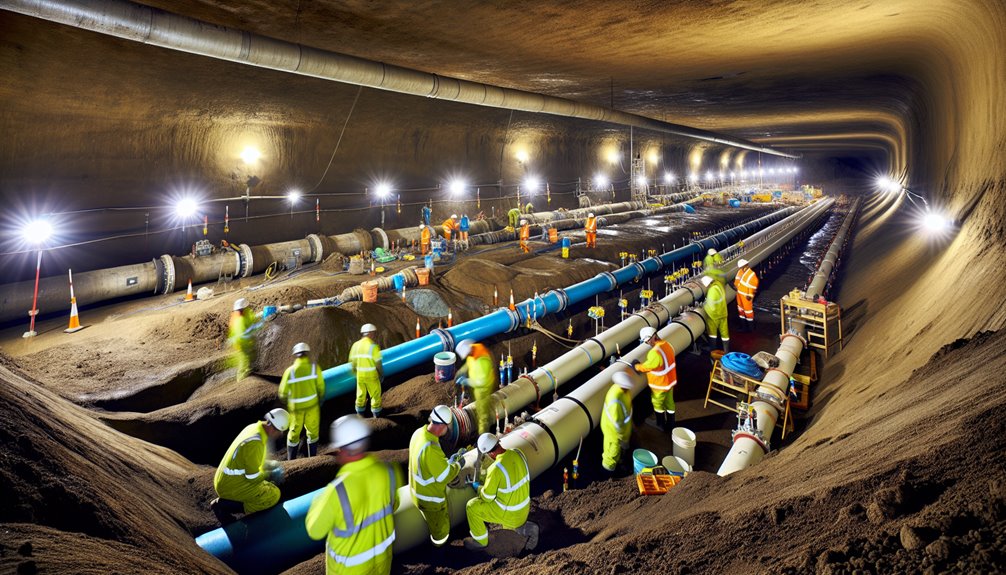
Building on the foundation of digital mapping and GIS in underground utility construction, it's equally important to focus on water conservation techniques.
You can integrate low-flow fixtures and water-efficient appliances to minimize consumption.
Utilize rainwater harvesting and greywater reuse systems to supply non-potable water needs sustainably.
Implementing strategic site planning with native plants and water-sensitive landscaping reduces the demand for irrigation.
Employ permeable pavements and green roofs to enhance groundwater recharge and decrease stormwater runoff.
Incorporating advanced water treatment technologies guarantees a sustainable supply.
The Role of Modular Construction in Reducing Waste
Given the notable waste reduction benefits of modular construction, it's crucial to take into account its role in sustainable building practices.
Through modular design, you can achieve superior waste management, greatly diminishing environmental impacts.
- Precision Material Usage: Modular construction enables up to 83.2% less waste by employing precise material estimates and minimizing over-ordering.
- Enhanced Reusability: Modular units offer easy relocation and reuse, dramatically cutting down on demolition waste and reducing the demand for new materials.
- Controlled Construction Environment: This method limits off-cuts and excess, thanks to a controlled factory setting that optimizes material use.
Implementing Eco-Friendly Practices in Urban Planning
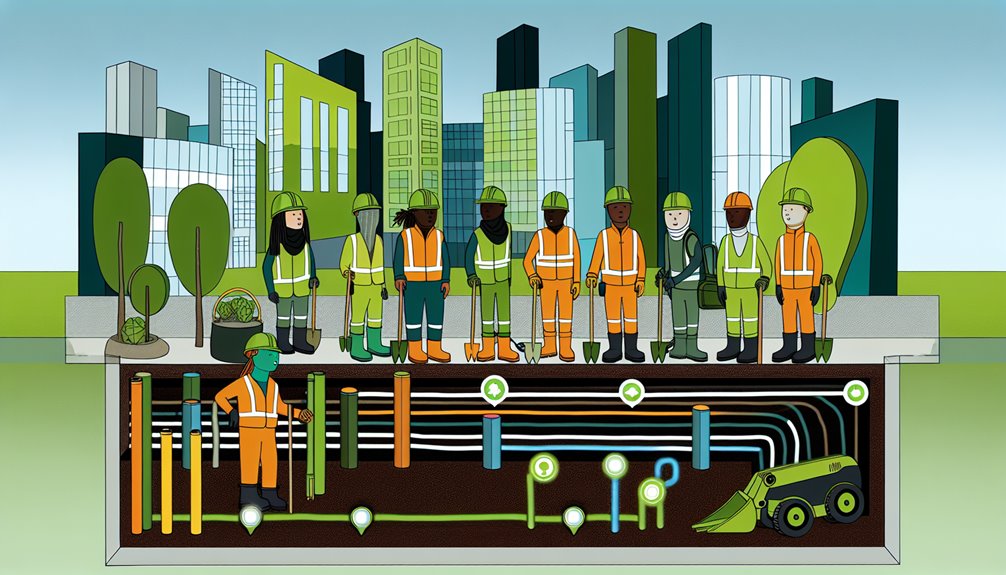
After exploring the waste reduction benefits of modular construction, it's important to contemplate how urban planning can also incorporate sustainable practices.
Embrace green urbanism by integrating parks, green roofs, and urban forests, which greatly improve air quality and reduce urban heat. You'll see that employing bioswales and rain gardens not only manages stormwater but also enhances water quality, contributing to sustainable landscapes.
Additionally, mixed-use zoning fosters walkable communities, reducing long commutes and emissions. By investing in efficient public transit and promoting cycling, you'll decrease reliance on private vehicles, mitigating greenhouse gas emissions.
These strategies collectively enhance urban resilience, promote biodiversity, and improve the quality of life, aligning with your innovative vision for sustainable urban environments.
Long-Term Benefits of Sustainable Utility Networks
As you consider upgrading to sustainable utility networks, remember that these systems not only enhance operational efficiency but also offer considerable long-term environmental and economic benefits.
- Resource Optimization: Predictive maintenance and IoT connectivity streamline operations, drastically cutting energy use and operational costs.
- Network Longevity: High-performance networks designed for minimal power consumption support the longevity of infrastructure, especially beneficial for renewable energy sectors like wind and solar.
- Economic and Environmental Gains: Trenchless technology and energy-efficient solutions greatly reduce both construction costs and carbon emissions, aligning with broader sustainability goals.
These innovations promise not only to improve your bottom line but also to guarantee your operations are future-proofed against evolving environmental standards.
Regulatory Frameworks Supporting Green Construction Practices
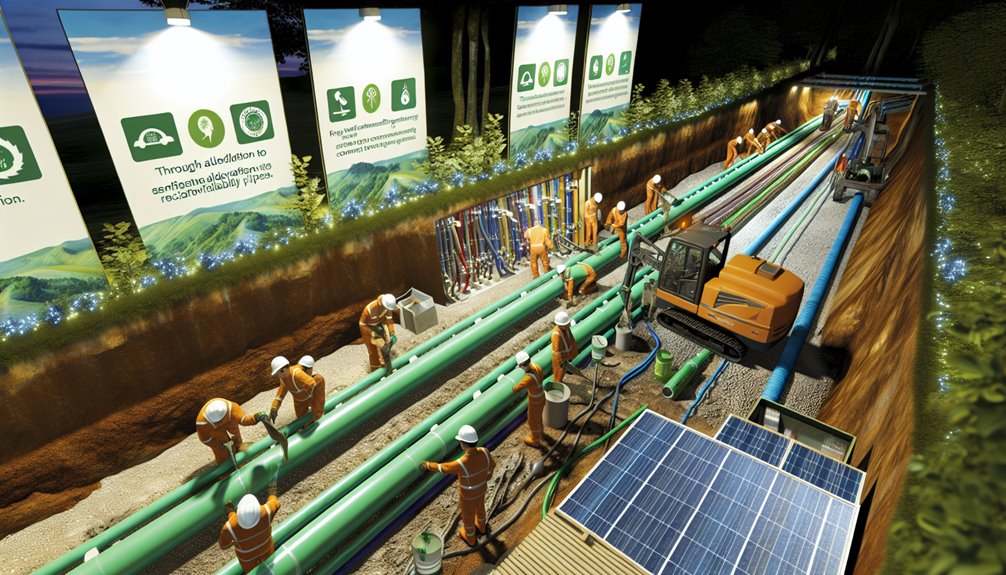
Building on the long-term benefits of sustainable utility networks, adequate regulatory frameworks are instrumental in ensuring these practices aren't only adopted but also effectively implemented.
The International Green Construction Code (IgCC) and the International Energy Conservation Code (IECC) set the stage by mandating minimum requirements for energy efficiency and environmental quality in underground utilities.
Overlaying these, specific green building regulations intensify standards, ensuring that projects align with advanced sustainable construction policies.
You'll encounter financial incentives and stringent compliance mechanisms, including penalties and mandatory reporting, pushing for high adherence to these regulations.
This synergy between codes and government policies fosters an environment where you're not just meeting basic compliance but are part of a transformative move towards sustainable development.
Conclusion
As you advance in underground utility construction, embracing trenchless technologies and eco-friendly materials is essential. By integrating digital mapping and advanced machinery, you're not just optimizing efficiency but also greatly reducing your carbon footprint. Remember, sustainable practices don't just comply with regulatory frameworks—they enhance the resilience of urban infrastructure. Adopting these methodologies guarantees your projects are future-proof, conserving resources and minimizing environmental impact for generations to come.
I invite you to learn more about these innovative practices and how we can help you implement them! Visit Boring Bros at boringbro.com or give us a call at (954) 639-6167. We're here to support you on your journey towards sustainable underground utility construction, and we'd love to chat!

